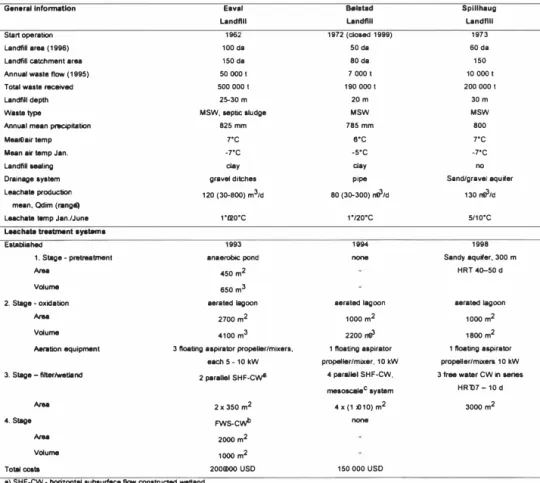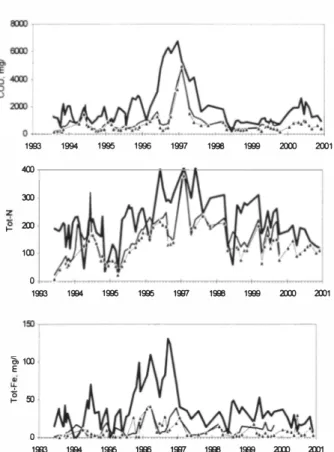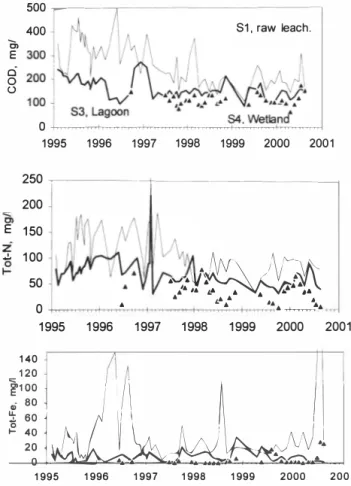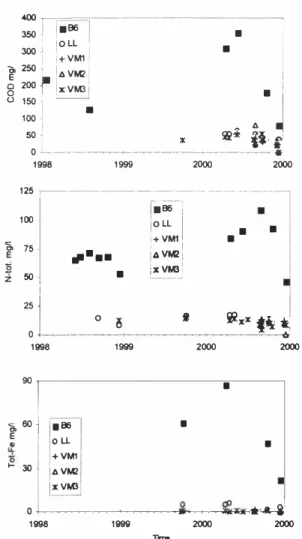9
KALMAR ECO-TECH'0I
Leachate and Wastewater Treatment with High-Tech and Natural systems KALMAR, SWEDEN, November 26-28, 200 I
TREATMENT WETLANDS FOR
LANDFILL LEACHATES - CASE STUDIES
FROM NORWAY
Ketil Haarstad, Trond Mreh/um and Per I. Kraft
Jordforsk, Norwegian Centre for Soil and Environmental Research, F. A. Dahls
v. 20, 1432 As, Norway
SUMMARYThe paper describes operational experiences of landfill leachate treatment systems at three Norwegian landfill sites, with emphasis on the reduction of COD, nitrogen and Fe concentrations. The leachate systems described consist of aerated lagoons with aspirator propeller aerators/mixers, and horizontal subsurface flow treatment wetlands. Results of leachate monitoring and treatment efficiencies are presented. Operational data show that leachate treatment with aerated lagoons has problems with removal of organic matter and nitrogen, but remove Fe. Failure seems to depend on high loads (especially in winter times), sludge erosion and toxicity. The hydraulic retention time should to be >20 days to keep the nitrifiers in the lagoon during periods with low temperatures. Simple filtration techniques with e.g. bark, shell or coral sand, crushed concrete and others can improve leachate quality both during and after other treatment stages and remove nitrogen, colour, heavy metals, organic pollutants and pesticides, and buffer pH and add other nutrients. A combination of aeration, dams and filtering techniques probably gives the best treatment options.
1. INTRODUCTION
Activated sludge systems are extensively used for leachate treatment in Europe. The leachate treatment method that used to be most common in the UK, extended aeration activated sludge, has relatively long retention time (3-10 days) with good results for removal of C and N. This is a common treatment method also in the rest of Europe (Ashbee and Fletcher 1993). Traditional activated sludge systems are generally not optimal due to high variation in leachate quality. Typical problems are foaming, precipitation and excessive sludge production. Aerated lagoon systems are the most frequent treatment option also in Scandinavia. It is a simple concept without recirculation of sludge and a high removal of C (Maris et al., 1994). Additional P is often recommended to enhance the biological processes (Robinson, 1997; Britz 1995; M�hlum et al., 1998). Minimal maintenance with retention time usually in the order of 3-20 days.
On-site treatment of landfill leachate is not widespread in Norway. Fewer than 20 of the 350 municipal sanitary waste (MSW) landfills use on-site biological treatment systems. About 35 landfills discharge raw leachate to sewers without on-site pretreatment. New regulations require that most landfills must be built with a liner to control leachate; and leachate treatment is compulsory. On-site "high-tech" leachate treatment systems are avoided due to high construction and operation costs. Low-cost treatment methods operating in cold climate need to be implemented. Several studies conclude that aerating lagoons removes COD and NH4-N
KALMAR ECO-TECH'0I
Leachate and Wastewater Treatment with High-Tech and Natural systems KALMAR, SWEDEN, November 26-28, 200 I
(e.g. Maris and Harrington, 1984, Robinson and Maris, 1985, Robinson and Grantham, 1988, Robinson, 1990). Constructed wetlands (CWs) have been used successfully as secondary and tertiary treatment of eftluent from aerated lagoons in UK (Robinson, 1993) and USA (Martin and Moshiri, 1995). CW properties that make them suitable for wastewater treatment include extensive adsorptive surfaces (sediments, plants and roots), aerobic-anaerobic interfaces, and diverse, active microbial populations, which will translocate, metabolise, or use the various contaminants. According to Robinson et al. ( I 997) there are no technical barriers to the treatment of landfill leachates to whatever standards are appropriate.
2. �---� E<06 E<06
i
1I
,□
•
•
□ □
•
□
•
□
•
8.E<OSi
'6 4,E<OS O.E<OO�---<
1991 1992 1993 1994 1995 1996 19Q7 1996 1999Figure 1. Trends in landfilled waste in Norway (SSB, 2001).
There are more than 3000 landfills in Norway, of which more than 500 are industrial, more than 1000 are municipal, and about 200 are in operation today. The public record of landfills has files for 1150 locations, of which 94 are registered closed. Total annual production of MSW is about 1.2 million tons (SSB, 1997). The volume of landfilled waste cannot be expected to decrease rapidly, in spite the effort to do so, see Figure 1. Both the public and government advocate more waste sorting, recycling and incineration to reduce landfilling. 20-30 % of MSW landfills treat leachate at waste water treatment systems. Less than 10 % receive some kind of local pre-treatment. Non-treated leachate is basically emitted from small landfills. The main recipients are fjord/coastal waters (36 %), rivers and streams (26 %) and soil (25%) (SSB 1997). The specific leachate production measured at Norwegian landfills is 50-200 me3/day, or 300-600 mm/year, about 30-60% of the precipitation, a relatively large production compared to other European countries. For on-site leachate treatment it is better to isolate the waste body from surface and groundwater from non-polluted areas. The hydrological properties of the landfill can be analysed with time series of leachate production and precipitation. Norwegian experiences show removals of COD 50-90%, Fe >70%, Tot-N 30-50% and NH4-N 0-99%. Seasonal effects have been observed (Mrehlum et al. 1998). High removal can be observed even during low temperatures or even floods due to the high buffering volume of the lagoon.
This study is based on detailed investigations of leachate from 3 landfills (Esval-referred to as e, Belstad-referred to as b and Spillhaug as s), from the southeastern part of Norway, from 1992-to date. In addition leachate data from 10 other landfills representing a variety in size (5-50 ha), age and hydrology, have been compiled and are presented here. The specific landfills have been described earlier (Mrehlum et al., 1995).
Ketil Haarstad, Trond Ma:hlum and Per I. Kraft, Norway 90
KALMAR ECO-TECH'0 I
Leachate and Wastewater Treatment with High-Tech and Natural systems KALMAR, SWEDEN, November 26-28, 2001
2. METHODS
All analyses are made at Jordforsk according to accredited methods and Norwegian standards. At Esval the leachate is sampled as weekly grab samples and analysed 6 to 8 times per year. The leachate volume is manually measured weekly. The electrical conductivity of the raw leachate is also sampled manually each week to monitor the weekly variability of the concentrations in the leachate. At B0lstad the leachate is sampled 6 to 8 times per year. The leachate volume is sampled continuously. At Spillhaug the leachate is analysed 5 to 10 times per year, and leachate volume is measured continuously. Leachate removal is calculated on a concentration basis without correction of Cl removal. Control calculations with removal on a weight basis showed little bias between the two methods.
-7'C
pipe KALMAR ECO-TECH'0 I
Leachate and Wastewater Treatment with High-Tech and Natural systems KALMAR. SWEDEN, November 26-28, 200 I
3. RESULTS
The landfills and leachate systems are described in Table 1. The sites have a cool temperate continental climate, with 800 mm annual precipitation and a January mean air temperature
around -6°C. Although leachate temperature and production rates are similar, one landfill (Esval)
is about twice as large as the other two, see Table I.
Table 1. Description of Esval, Bolstad and Spillhaug MSW landfills and treatment plants in Norway.
General Information E1v■I llelatad Splllhaug
Landfill Landfill Landfill
Start operation 1962 1972 (cloaed 1999) 1973
Landfill area (1996) 100 de SO da 60 da landfill catchment aru 150 da 80 da 150
Annual waste flow (1995) SO 000 t 7 000 t 10 000 t Total waste received 500 000 t 190 000 t 2 00 000 t Landfill depth 25-30 m 20m 30m
Waste type MSW. septic aludge MSW MSW
Annual mean prwcipitation 82 5mm 785mm 800
Mun0aW'temp 7'C e·c 7'C
Mean air temp Jan. -7'C -s·c
Landfill aealing clay clay no
Drainage ayatem gravel ditches
Leachate production
Sand/gravel aquifer
120 ( 30-800) m3td 80 (30-300) m03td 130 m03/d
mean, Qdim (range0)
Leachate temp Jan./June 1'/020'C 1·12o·c 5/10'C
LNchata trutment •vetem•
E-hed 1. Stage - pretreatment AIM Volume 2. Stage - oxklation AIM Volume Aeration equipment 3. Stage - filter/wetland AIM 4. Stage AIM Vdume Tot.coats 1993 anaerobic pond 4 50m2 650m3 aerated lagoon 2 700 m2 4100 m3
3 floating aapirlltor propeUer/mixers, each 5-10 kW 2 parallel SHF-Cw" 2 x 350m2 FWS-Cw' 2000 m2 1000 m2 2000000 USO 1-none aerated lagoon 1000 m2 22 00 m03 1 floating aspirator propeller/mixer, 10 kW 4 parallel SHF-CW. mnoacMc system 4x(1x010)m2 none 150 000 USO 1998 Sandy aquifer. 300 m HRT 40-50 d aerated �oon 1000 m2 1800 m2 1 floating aspirator propelter/mixera 10 kW 3 free water CW in Mfies
HRT07-10d 3000 m2
a ) SHF-CW • horizontal subsurface flow constructed wetland
Ketil Haarstad, Trond Ma:hlum and Per I. Kraft, Norway
KALMAR ECO-TECH '0 I
Leachate and Wastewater Treatment with High-Tech and Natural systems KALMAR, SWEDEN, November 26-28, 200 I
3, 1, Esval 1993 1994 1995 1996 1997 1996 1999 2000 2001 400 :m 200 t,-100 0 1993 1994 1995 1995 1997 1!Hl 1999 2000 2001 � 100 E
� �
0 1993 1994 1995 1!1l6 1997 1!Hl 1999 2000 2001Figure 2. Time series in mg/L of organic matter (COD), nitrogen (Tot-NJ and iron (Tot-Fe) from Esva/ Landfill (raw leachate=heavy line, lagoon=thin line, wetland=triangles)
The leachate at Esval has changed considerably during the operation of the treatment system. For COD and Fe there is a peak concentration from 1996- 1 997. The system has not been able to remove the prescribed 75% COD and 45% Tot-N, It is also clear that the wetland has low removal, mainly due to hydraulic and chemical overloading.
�
L1,,. .& A1,,. L A : 11,,. .&� • .
KALMAR ECQ..TECH'0 I
Leachate and Wastewater Treatment with High-Tech and Natural systems KALMAR, SWEDEN, November 26-28, 2001
3.2. B0lstad 500 ---�---� S1, raw leach. 400
m
E ci 0 l) 0 +,--,-,-�=t-�·�-,+,--,-�=.t��-��t,--,-,-,�rrrl 1995 1996 1997 1998 1999 2000 2001250
---+---�
200
E 150
.!.100
50
,..., .. !JI,.
1,,. l1,,.11,,...
'
_,.,. ,,.
.
..
i,0
..
1995
1996
1997
1998
1999 2000
2001
140t!ildl�UJJ
1995 1996 1997 1998 1999 2000 2001Figure 3. Time series in mg/L of organic matter (COD), nitrogen (J'ot-N) and iron (J'ot-Fe) from Belstad Landfill (raw leachate=line, lagoon=heavy line, wetland=triangles).
At 80lstad the wetland has higher removal. Also here the removal of COD is not up to the target value of75% removal.
Ketil Haarstad, Trond Mzhlum and Per I. Kraft, Norway
-
-�
OLL I : +VM1 I i XVM3 ii x x , � --, o Ll xVM3 , KALMAR ECO-TECH'0ILeachate and Wastewater Treatment with High-Tech and Natural systems KALMAR, SWEDEN, November 26-28, 2001
3.3. Spillhaug
-i
:-
1
■B6
- ---
,
■
1
■ , 300 J Ir
2 !t. VM2i
50 .,_ 2001 8 !xvM3i • u 1 1 100, 50j
• x 50iii*
il·
.
j
0 -'--' ---��---�----.--. 1998 1999 2000 2000 125 �··- ---- ---100•
FJ
• •
�
E 75...
t. VM2•
ciI
50:I
0 0 I 1998 1999 2000 2000•
�
�I
601
■es
•
•
E +VM1 I- 30 t.VM20
+---~��-+----��-----+-,-... � 1998 1999 2000 2000 Tm,Figure 4. Trends in COD, Tot-N and Fe at Spillhaug landfill (B6=upstream groundwater well close to the landfill, LL=aerated lagoon, VMJ-3=wetlands)
At Spillhaug the removal is above the target values. Here the concentrations are much lower due to infiltration to groundwater before treatment in the lagoon and wetlands.
�
--
--
•
.. ... ·. '.:
\�
45 43 47 53 KALMAR ECO-TECH'0ILeachate and Wastewater Treatment with High-Tech and Natural systems KALMAR, SWEDEN, November 26-28, 2001
4. SUMMARY
Figures 2-4 shows that the leachate at Esval is moderatly strong, and at B0lstad and Spillhaug the leachates are weak. Esval experienced an increase in concentrations during 1996-1998, probably due to high input of waste producing leachate in the acetogenic phase. 2000 was a exceptionally wet year and can be seen as an increase in COD and N concentrations at Esval and B0lstad. A summary of the annual mean removal of organic matter, nitrogen and iron is shown in Table 2.
Table 2. Time series o[_ annual mean removal, SJ!_Stems includins_ all treatment stages ("/4)
Esval B0lstad S�illhaug
Year COD N Fe COD N Fe COD N Fe
1993 86 83 89 1997 65 80 38 61 64 97 70 75 80 99 1998 56 87 27 26 1999 40 84 36 68 2000 59 28 55 41 60 90 81 87 99
Table 2 shows that for the two landfills Esval and B0lstad, the removal of organic matter and nitrogen is occasionally below target values, usually 75 % removal for COD and 45 % for total nitrogen. The systems are better in removing iron (and other metals). The reasons for malfunctioning of the systems can be several: the hydraulic loading or the loading of organic matter and nutrients is higher than the system design, the hydraulic detention time is not according to specifications (shortcuts), flooding and erosion of the lagoons, or the leachate is too toxic for the given treatment option.
The hydraulic retention time should to be >20 days to keep the nitrifiers in the lagoon during periods with low temperatures. Liquid temperature will be an important factor especially at high latitudes. 250 25 -1<01,..ft ... ,,.. .. ,\ .,,\, ,,,. r'' ,,'-\ : � a IQ!.H"-1 I \ / \ ' ' 1 2IXI ,' \ I \ I ' .,, I ,o I -1+111,,N ,_ . . , .. ,,. / ' ,' \ ,' \,, •• 1 • I
i ::
M
A
'., '-
-·-
r�1'\
��
I;,
�
"
I . ::::.
.. ··
i:
. . • • . f-45 0 _:__.. i_..;1?!�� ..
Figure 5. Lagoon temperature and concentrations of N03-N and NH4-N in raw leachate and
effluent aerated lagoon and CW (mesoscale) of landfill b, as response to changing temperatures
and addition of supplemental phosphorous.
Ketil Haarstad, Trond Mrehlum and Per I. Kraft, Norway 96
KALMAR ECO-TECH'0I
Leachate and Wastewater Treatment with High-Tech and Natural systems KALMAR, SWEDEN, November 26-28, 2001
REFERENCES
I . Ashbee, E. and L Fletcher. ( I 993). Reviewing the options for leachate treatment. Wastes Management, 8, 32-33.
2. Haarstad, K., Mrehlum, T. 1 999. MSW Leachate variability and alternative pre-treatment filter in cold, temperate climates. In: Christensen, T.M., Cossu, R., Stegmann, R. (Eds.): Leachate, gas, operation and health effects in landfills. Proceedings Sardinia 99, Vol. IL CISA, via Marenge 34, 1-09 I 23 Cagliari, pp. 2 1 5-224.
3. Mrehlum, T., Haarstad, K. and Kraft, P. ( 1 995). On-site treatment of landfill leachate in natural systems. In: Christensen, T.H., Cossu, R. and Stegmann, R.: Proc. Sardinia 1 995, Fifth Int. Landfill Symp, Cagliari, Italy., Vol I, 463-468.
4. Mrehlum, T., Haarstad, K. 1 997. Leachate treatment in ponds and wetlands in cold climate. In:
Christensen, T.M., Cossu, R., Stegmann, R. (Eds.): Leachate and landfill gas management Proceedings Sardinia 97, Vol. IL CISA, via Marenge 34, 1-09 1 23 Cagliari, pp. 337-344.
5. Maris, P.J. and Harrington, D. W. (I 984). Leachate treatment with particular reference to aerated lagoons. Water Pollution Control, 83, 4, 52 1 -538.
6. Martin, C.D. and Moshiri, G.A. ( 1 992). Nutrient reduction in an in-series constructed wetland system treating landfill leachate. In: Proc. International Specialist Conference - Wetland Systems in Water Pollution Control. University of New South Wales, Sydney, Australia.
7. Robinson, H.D. and Maris, P.J. ( I 985). The treatment of leachates from domestic waste in landfill sites. Journal WPCF, 57, I , 30 - 38.
8. Robinson, H. R. and Grantham, G. ( 1 988). The treatment of landfill leachates in on-site aerated lagoon plants: Experience in Britain and Irland. Wat.Res., 22, 6, 733 - 747.
9. Robinson, H.D. ( 1 990). On-site treatment of leachates from landfilled wastes. Journal of The Institution of Water and Environmental Management, 4, I , 78 - 89. London, England.
I O. Robinson, H.D., Last, S.D., Raybould, A., Savory, 0., Walsh, T.C. 1 997. State of the art landfill leachate treatment schemes in the United Kingdom. In: Christensen, T.M., Cossu, R., Stegmann, R. (Eds.): Leachate and landfill gas management. Proceedings Sardinia 97, Vol. IL CISA, via Marenge 34, 1-09 1 23 Cagliari, pp. 1 9 1 -2 I O.
1 1 . SSB. State pollution agency. 200 1 .




